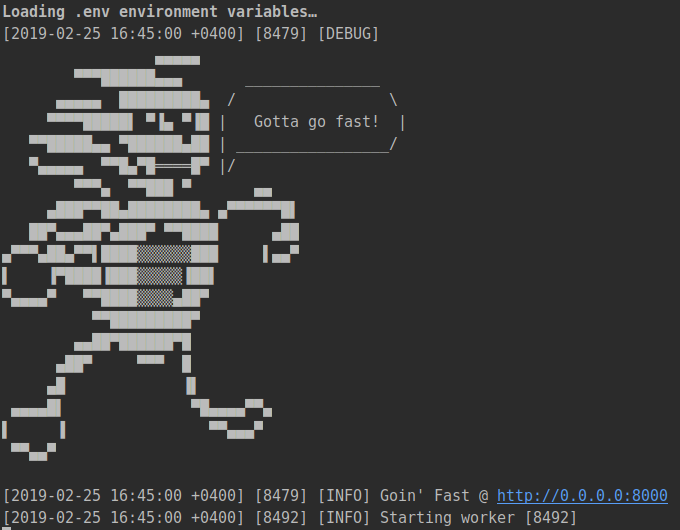by Davit Tovmasyan
How to make your code fast and asynchronous with Python and Sanic
Hello everybody. In this article I’ll talk about building simple asynchronous projects with the Sanic framework.

Introduction
Sanic is a very flask-like open-source Python web server and web framework with more than 10K stars that’s written to go fast. It allows the usage of async/await syntax added in Python 3.5 (read more), which makes your code non-blocking and speedy.
Sanic has pretty good documentation and it’s maintained by the community, for the community.
The goal of the project is to provide a simple way to get a highly performant HTTP server up and running that is easy to build, to expand, and ultimately to scale.
Requirements
Before we start, let’s install some packages and make sure that we have everything ready for the development of this project.
Note: Source code is available in my github.com repository. For each step there is a corresponding commit.
Prerequisites:
- Python3.6+
- pipenv (you can use any other package installer)
- PostgreSQL (for database, can also be MySQL or SQLite)
Packages:
- secure is a lightweight package that adds optional security headers and cookie attributes for Python web frameworks.
- environs is a Python library for parsing environment variables. It allows you to store configuration separate from your code, as per The Twelve-Factor App methodology.
- sanic-envconfig is and extension that helps you bring command line & environment variables into your Sanic config.
- databases is a Python package that allows you to make queries using the powerful SQLAlchemy Core expression language, and provides support for PostgreSQL, MySQL, and SQLite.
Let’s create an empty directory and initialize an empty Pipfile there.
pipenv -- python python3.6Install all necessary packages using pipenv commands below.
pipenv install sanic secure environs sanic-envconfigFor database:
pipenv install databases[postgresql]Choices are postgresql, mysql, sqlite.
Structure
Now let’s create some files and folders where we will write our actual code.
├── .env├── Pipfile├── Pipfile.lock├── setup.py└── project ├── __init__.py ├── __main__.py ├── main.py ├── middlewares.py ├── routes.py ├── settings.py └── tables.pyWe will use the setup.py file to make the project folder available as a package in our code.
from setuptools import setupsetup( name='project',)Installing…
pipenv install -e .In the .env file, we’ll store some global variables like the database connection URL.
__main__.py is created for making our project package executable from the command-line.
pipenv run python -m projectInitialization
Let’s do our first call in __main__.py file.
from project.main import initinit()This is the beginning of our application. Now we need to create the init function inside of main.py file.
from sanic import Sanicapp = Sanic(__name__)def init(): app.run(host='0.0.0.0', port=8000, debug=True)Simply creating the app from the Sanic class we can run it specifying host, port and optional debug keyword argument.
Running…
pipenv run python -m project
This is how a successful output should look in your Sanic app. If you open http://0.0.0.0:8000 on your browser you’ll see
Error: Requested URL / not found
We haven’t created any routes yet, so it’s fine for now. We will add some routes below.
Settings
Now we can modify the environment and settings. We need to add some variables in the .env file, read them, and pass to Sanic app config.
.env file.
DEBUG=TrueHOST=0.0.0.0POST=8000Configuration…
from sanic import Sanicfrom environs import Envfrom project.settings import Settingsapp = Sanic(__name__)def init(): env = Env() env.read_env() app.config.from_object(Settings) app.run( host=app.config.HOST, port=app.config.PORT, debug=app.config.DEBUG, auto_reload=app.config.DEBUG, )settings.py file.
from sanic_envconfig import EnvConfigclass Settings(EnvConfig): DEBUG: bool = True HOST: str = '0.0.0.0' PORT: int = 8000Please note that I’ve added an optional auto_reload argument which will activate or deactivate the Automatic Reloader.
Database
Now it’s time to setup a database.
One little note about the databases package before we go ahead:
databases package uses asyncpg which is an asynchronous interface library for PostgreSQL. It’s pretty fast. See results below.

We will use two of Sanic’s listeners where we will specify database connect and disconnect operations. Here are the listeners that we are going to use:
- after_server_start
- after_server_stop
main.py file.
from sanic import Sanicfrom databases import Databasefrom environs import Envfrom project.settings import Settingsapp = Sanic(__name__)def setup_database(): app.db = Database(app.config.DB_URL) @app.listener('after_server_start') async def connect_to_db(*args, **kwargs): await app.db.connect() @app.listener('after_server_stop') async def disconnect_from_db(*args, **kwargs): await app.db.disconnect()def init(): env = Env() env.read_env() app.config.from_object(Settings) setup_database() app.run( host=app.config.HOST, port=app.config.PORT, debug=app.config.DEBUG, auto_reload=app.config.DEBUG, )Once more thing. We need to specify DB_URL in project settings and environment.
.env file.
DEBUG=TrueHOST=0.0.0.0POST=8000DB_URL=postgresql://postgres:postgres@localhost/postgresAnd settings.py file.
from sanic_envconfig import EnvConfigclass Settings(EnvConfig): DEBUG: bool = True HOST: str = '0.0.0.0' PORT: int = 8000 DB_URL: str = ''Make sure that DB_URL is correct and your database is running. Now you can access to database using app.db. See more detailed information in the next section.
Tables
Now we have a connection to our database and we can try to do some SQL queries.
Let’s declare a table in tables.py file using SQLAlchemy.
import sqlalchemymetadata = sqlalchemy.MetaData()books = sqlalchemy.Table( 'books', metadata, sqlalchemy.Column('id', sqlalchemy.Integer, primary_key=True), sqlalchemy.Column('title', sqlalchemy.String(length=100)), sqlalchemy.Column('author', sqlalchemy.String(length=60)),)Here I assume that you already have a migrated database with a books table in it. For creating database migrations, I recommend that you use Alembic which is a lightweight and easy-to-use tool that you can use with the SQLAlchemy Database Toolkit for Python.
Now we can use any SQLAlchemy core queries. Check out some examples below.
# Executing manyquery = books.insert()values = [ {"title": "No Highway", "author": "Nevil Shute"}, {"title": "The Daffodil", "author": "SkyH. E. Bates"},]await app.db.execute_many(query, values)# Fetching multiple rowsquery = books.select()rows = await app.db.fetch_all(query)# Fetch single rowquery = books.select()row = await app.db.fetch_one(query)Routes
Now we need to setup routes. Let’s go to routes.py and add a new route for books.
from sanic.response import jsonfrom project.tables import booksdef setup_routes(app): @app.route("/books") async def book_list(request): query = books.select() rows = await request.app.db.fetch_all(query) return json({ 'books': [{row['title']: row['author']} for row in rows] })Of course we need to call setup_routes in init to make it work.
from project.routes import setup_routesapp = Sanic(__name__)def init(): ... app.config.from_object(Settings) setup_database() setup_routes(app) ...Requesting…
$ curl localhost:8000/books{"books":[{"No Highway":"Nevil Shute"},{"The Daffodil":"SkyH. E. Bates"}]}Middlewares
What about checking the response headers and seeing what we can add or fix there?
$ curl -I localhost:8000Connection: keep-aliveKeep-Alive: 5Content-Length: 32Content-Type: text/plain; charset=utf-8As you can see we need some security improvements. There are some missing headers such as X-XSS-Protection, Strict-Transport-Security… so let’s take care of them using a combination of middlewares and secure packages.
middlewares.py file.
from secure import SecureHeaderssecure_headers = SecureHeaders()def setup_middlewares(app): @app.middleware('response') async def set_secure_headers(request, response): secure_headers.sanic(response)Setting up middlewares in main.py file.
from project.middlewares import setup_middlewaresapp = Sanic(__name__)def init(): ... app.config.from_object(Settings) setup_database() setup_routes(app) setup_middlewares(app) ...The result is:
$ curl -I localhost:8000/booksConnection: keep-aliveKeep-Alive: 5Strict-Transport-Security: max-age=63072000; includeSubdomainsX-Frame-Options: SAMEORIGINX-XSS-Protection: 1; mode=blockX-Content-Type-Options: nosniffReferrer-Policy: no-referrer, strict-origin-when-cross-originPragma: no-cacheExpires: 0Cache-control: no-cache, no-store, must-revalidate, max-age=0Content-Length: 32Content-Type: text/plain; charset=utf-8As I promised at the beginning, there is a github repository for each section in this article. Hope this small tutorial helped you to get started with Sanic. There are still many unexplored features in the Sanic framework that you can find and check out in the documentation.
davitovmasyan/sanic-project
Goin' Fast and asynchronous with Python and Sanic! - davitovmasyan/sanic-projectgithub.com
If you have thoughts on this, be sure to leave a comment.
If you found this article helpful, give me some claps ?
Thanks for reading. Go Fast with Sanic and good luck!!!
